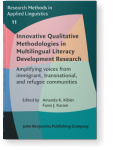Chapter 2
Rethinking qualitative meta-syntheses in literacy studies
Critical questions
This chapter presents a critical examination of
qualitative meta-synthesis in literacy research, emphasizing its
role in amplifying student voices and uncovering overlooked aspects
of educational practices. Drawing from a previously published
meta-synthesis on adolescent experiences in reading intervention
courses (RICs), the chapter reveals challenges in applying findings
to linguistically diverse students due to inconsistencies in data
representations of multilingualism. The chapter underscores the
potential of attentive data analysis and proposes two critical
question sets to vet studies to ensure nuanced representations of
linguistic diversity. By advocating for thorough analyses in
original research and refining meta-synthesis methodology, the
chapter underscores the significance of addressing multilingual
students’ experiences in literacy education.
Article outline
- Introduction
- Overview of the study and its findings
- Setting the stage for meta-synthesis research
- Round 1: EL-identified high school students
- Round 2: Language background analysis
- Methodological discussion: Rethinking data for more equitable
research
- Absence of bureaucratic label
- Absence of descriptions of language background
- Implications for qualitative research on multilingual literacy
development
- Critical question sets
- Attending to the method section
-
References
This content is being prepared for publication; it may be subject to changes.
